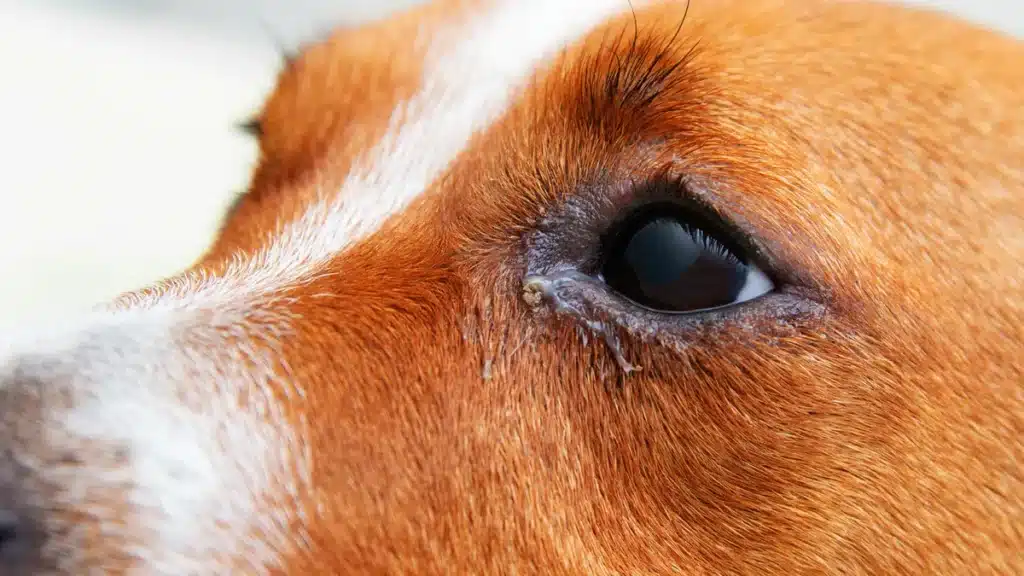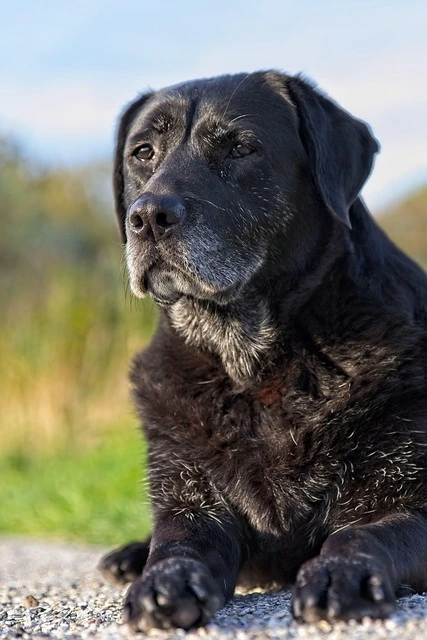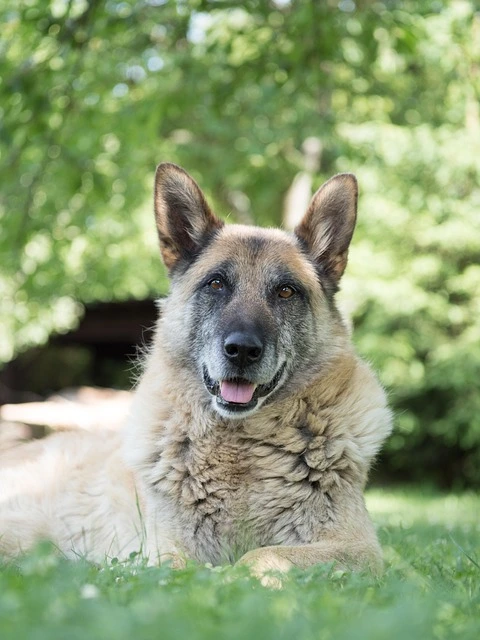If your dog’s eyes are watery, crusty, or producing thick yellow-green gunk, you’re looking at dog eye discharge—a sign that can range from harmless tear film to serious infections. This guide breaks down the causes, safe home remedies, mistakes to avoid, prevention tips, and when to seek veterinary care, so you can keep your dog’s eyes clear, comfortable, and healthy.

Table of Contents
Common Causes of Dog Eye Discharge
Dog eye discharge isn’t always a cause for panic—but it’s rarely something to ignore. The color, texture, and amount can tell you a lot about what’s going on.
1. Allergies & Environmental Irritants
Just like us, dogs can react to pollen, dust, mold spores, or smoke. Seasonal allergies often cause clear, watery tears that may increase in spring or fall.
Signs you might see:
- Excessive blinking or squinting
- Watery eyes without thick mucus
- Pawing at the face after being outside
For mild, allergy-related tearing, a gentle rinse can work wonders. The Nutri-Vet Eye Rinse for Dogs is pH-balanced, non-stinging, and designed to flush out pollen, dust, and other irritants before they cause more problems.
2. Bacterial and Viral Infections
When discharge turns yellow, green, or pus-like, infection is the prime suspect. Eye infections can develop after a scratch, foreign body, or even a respiratory virus.
Other symptoms may include:
- Redness and swelling
- Crusty buildup sealing the eyelids shut in the morning
- Sensitivity to light
While infections require vet-prescribed medication, keeping the eye clean in the meantime helps your dog stay more comfortable. The Vets Preferred Eye Wash for Dogs is a safe, vet-formulated saline solution that gently removes mucus and debris without stinging.
3. Dry Eye (Keratoconjunctivitis Sicca – KCS)
Dry eye happens when your dog’s tear glands don’t produce enough natural tears. Without that moisture, the eye becomes irritated and vulnerable to infection.
Typical signs include:
- Thick, sticky mucus that returns quickly after cleaning
- Dull, dry-looking eye surface
- Frequent blinking or squinting
Dry eye is often a lifelong condition, but with proper management, dogs can stay comfortable. Between prescribed treatments, the Vetericyn Plus Dog and Cat Eye Wash helps keep the eye hydrated and clean, reducing discomfort.
4. Foreign Bodies and Eye Injuries
Dogs that love the outdoors—think retrievers tearing through tall grass—are more likely to get seeds, sand, or twigs in their eyes. The result is sudden tearing, squinting, and visible discomfort. If you suspect something’s in your dog’s eye:
- Avoid rubbing or trying to dig it out
- Gently flush with saline
- See a vet promptly to prevent scratches or infection
5. Structural and Breed-Specific Issues
Some breeds are built for more eye trouble than others:
- Flat-faced breeds (Pugs, French Bulldogs): Shallow sockets cause poor tear drainage and more exposure to irritants.
- Loose-lid breeds (Bloodhounds, Saint Bernards): Eyelids that roll inward or outward can rub and irritate the eye.
- Long-haired breeds (Cocker Spaniels, Maltese): Hair constantly brushing the eye traps debris and moisture.
Daily cleaning is essential for these breeds, especially after outdoor play.
6. Tear Staining
In light-coated dogs, reddish-brown streaks under the eyes are often from porphyrins—pigments in tears that oxidize when exposed to air. While mostly cosmetic, heavy staining can point to chronic tearing or blocked tear ducts.
Safe Home Remedies for Mild Dog Eye Discharge
Important: These remedies are for mild, non-painful cases. If your dog’s discharge is thick, colored, or paired with swelling, see your vet first.
Gentle Eye Cleaning
Use a fresh cotton pad for each eye and wipe from the inner corner outward. A product like the Vets Preferred Eye Wash is ideal for this—it’s non-stinging, vet-approved, and perfect for daily maintenance.
Flushing Allergens
If your dog’s eyes water after walks in pollen season, rinse them with the Nutri-Vet Eye Rinse to remove irritants before they cause prolonged tearing.
Antimicrobial Support
When there’s mild redness or early irritation, the Vetericyn Plus Eye Wash helps flush bacteria and soothe the eye, making it a good first-aid item to keep on hand.
Chamomile Compress
Brew a chamomile tea bag, let it cool completely, and hold it gently over your dog’s closed eye for 2–3 minutes. This can help calm minor inflammation.
Common Mistakes to Avoid
- Using human eye drops: Many contain chemicals unsafe for dogs.
- Neglecting daily cleaning: Chronic tearing can lead to skin irritation or infection.
- Reusing cloths or pads: This can spread bacteria between eyes.
- Waiting too long for vet care: Eye problems can worsen rapidly.
When to See a Vet
Call your vet promptly if your dog has:
- Thick yellow, green, or bloody discharge
- Swelling, redness, or persistent squinting
- Cloudy eyes or sudden vision changes
At the clinic, your vet may perform:
- Tear production testing
- Ulcer detection with fluorescein stain
- Eyelid and duct evaluation
- Prescription of antibiotics, lubricants, or anti-inflammatory drops
Prevention Tips
- Daily eye checks: Catch redness, swelling, or discharge early.
- Routine cleaning: Especially for flat-faced or long-haired breeds.
- Grooming: Keep hair trimmed around eyes to reduce irritation.
- Allergy management: Use air purifiers indoors and rinse eyes after high-pollen walks.
- Diet: Omega-3 supplements support overall eye health. Beyond omega-3s, certain vitamins and minerals play crucial roles in maintaining your dog’s vision and tear production over the long term.
Breed & Seasonal Considerations
- Flat-faced breeds: Require more frequent lubrication and cleaning.
- Long-haired breeds: Benefit from regular grooming to prevent debris buildup.
- Active outdoor dogs: Rinse eyes after hikes or field play to remove dust and seeds.
- Seasonal changes: Pollen in spring, mold in fall, and dry indoor air in winter can all worsen discharge. Adjust care routines accordingly.
FAQs About Dog Eye Discharge
Is all discharge a sign of illness?
No—small amounts of clear fluid or light crust after sleep are normal.
Can I use tap water to clean my dog’s eyes?
It’s better to use sterile saline or a vet-approved rinse to avoid introducing bacteria.
Why does my dog’s tear staining smell?
Bacteria or yeast can grow in damp fur, causing odor.
Are some dogs more prone to eye problems?
Yes—flat-faced, loose-lid, and long-haired breeds tend to have more discharge issues.
How can I tell if my dog’s eye problem is urgent?
Rapid swelling, colored discharge, or visible injury require immediate veterinary care.
Conclusion
Dog eye discharge is common, but knowing when it’s harmless and when it’s a warning sign can make all the difference. With daily care, the right cleaning products, and prompt veterinary attention for serious cases, you can keep your dog’s eyes bright and comfortable.

